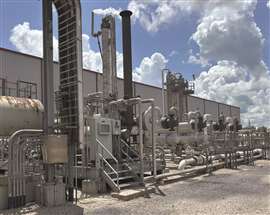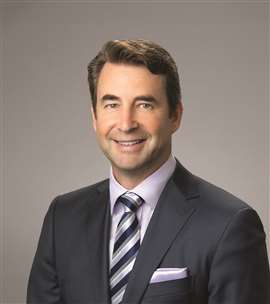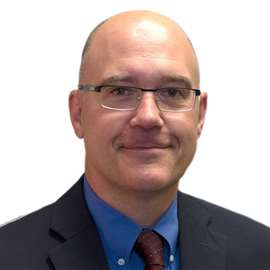Read this article in Français Deutsch Italiano Português Español
CapturePoint sees growing role for CO₂ infrastructure in decarbonizing gas sector
September 20, 2025
CEO Greg Harper outlines compression needs, midstream integration, and CCS market growth
 A CO2 capture and processing facility in Coffeyville, Kansas.
A CO2 capture and processing facility in Coffeyville, Kansas.
CapturePoint, a fast-growing player in carbon capture and storage (CCS), is betting on the natural gas sector’s infrastructure as the backbone of a rapidly scaling carbon management industry. In a recent interview, CEO Greg Harper described how the company is leveraging compression technologies, legacy pipeline assets, and subsurface expertise to develop regional sequestration hubs across North America.
“Our vision is to be recognized as a leading developer, operator and service provider of carbon management infrastructure,” Harper said. “We’re creating win-win opportunities with natural gas producers, processors, and midstream operators.”
Midstream builds the bridge
CapturePoint’s business model revolves around integrating CO₂ capture into existing energy operations. The company’s contract with ETC in Central Louisiana offers a clear example: CO₂ is captured at the gas processing stage before it enters the atmosphere, then transported to permanent underground storage.
“From a broader perspective, midstream operators can repurpose or expand some existing pipelines to transport captured CO₂ to storage sites,” Harper said. “That allows us to accelerate timelines and lower costs by leveraging infrastructure already in place—rights-of-way, compression stations, control systems, and operational know-how.”
 Greg Harper
Greg Harper
This integration also supports emerging opportunities in low-carbon LNG and hydrogen, where CO₂ emissions from natural gas feedstocks must be mitigated to meet regulatory and market expectations.
Engineering for CO₂, not methane
While midstream operators are well-equipped to handle high-pressure gases, carbon dioxide requires specific material, design, and operational adjustments. “There are key differences in how CO₂ behaves compared to natural gas,” Harper explained.
CO₂ is most efficiently transported in a highly compressed supercritical state, typically above 1,200 psig, requiring more robust materials and higher compression ratios than those used in typical gas transmission. Dehydration is critical to avoid carbonic acid formation, which can cause internal corrosion in carbon steel pipelines.
CapturePoint works closely with vendors and OEMs that understand the thermal and mechanical dynamics of CO₂ compression. “Reliability is everything,” Harper said. “With 45Q credits tied to uptime, even small failures have major consequences. That’s why our vendors must understand the science of CO₂.”
Site selection and subsurface science
CapturePoint holds more than 285,000 acres of geologic storage rights, and Harper said site selection is driven by a trio of factors: subsurface suitability, regional economic benefit, and community impact.
“Our subsurface team is one of our special sauces,” Harper noted. “They are to CO₂ storage what great E&P teams are to hydrocarbon production—only their job is to find places to put molecules back into the ground safely.”
When viable sites align with existing pipeline corridors, the economics and logistics of a CCS hub become far more attractive. “Location, location, location—that’s what we live by,” Harper added.
The company begins every project with a geological and regulatory screen. “We look for sealing formations, pore space, fault-free zones, and good landowner and mineral rights frameworks,” Harper said. “From there, we build outward—designing a transport and injection system around the best rocks we can find.”
Addressing community concerns head-on
A central concern for CapturePoint is the spread of misinformation. Harper said he’s been surprised by the level of public misunderstanding around CO₂ safety.
“There’s a lot of false narratives online—people comparing CO₂ to explosive oil or gas leaks, which is just not accurate,” he said. “CO₂ is not flammable. It’s used in fire extinguishers, not to start fires.”
CapturePoint engages first responders, local governments, and community leaders early in the development process. “We want them to understand how CO₂ works, how we’ll monitor and manage it, and what they need to have in place,” Harper said. “We’re even setting up local funds to support training and equipment purchases for emergency personnel.”
“This isn’t new technology,” he added. “It’s been around for decades, but it’s new to some communities, especially where oil and gas development hasn’t had a presence before. So, we start with education and support.”
The company has also taken a leadership role in briefing elected officials, funding responder training, and launching community benefit initiatives, particularly in parishes where CCS is entering for the first time.
From tax credits to market demand
While many CCS projects initially gained momentum through the federal 45Q tax credit program, Harper said the sector is shifting toward a more commercial footing.
“There’s a real market pull for low-carbon fuels, especially in LNG and sustainable aviation fuel,” he said. “What started as a compliance-driven business is becoming a demand-driven one.”
Harper cited recent partnerships with energy, chemical and DAC companies as evidence that industrial emitters increasingly see carbon storage as a competitive advantage. “We’re building a business model that will go from tax credit-supported to full midstream-style contracting,” he said.
“The foundation was tax credit-driven,” Harper added, “but the future is in market pull. Companies are looking to decarbonize everything—from fuels to packaging—and they’re willing to pay for reliable storage.”
Vision of a mature carbon market
Harper envisions a mature CCS market operating much like today’s natural gas midstream sector.
“Capture at the source, process it if needed, transport it safely, and inject it securely. That’s how we see this evolving,” he said. “Just like gas midstream, we’ll have point-source purification, compression, regulated transport, and contracted storage.”
As policies and carbon markets mature, Harper expects CCS infrastructure to become standard across major industries. “We want CapturePoint to be structured like a midstream company in five to six years.”
“In the future, we’ll be treating CO₂ just like gas,” he said. “We’ll have gathering systems, processing equivalents for dehydration and purification, long-distance transport, and large-scale, contracted storage. That’s the roadmap.”
Regulatory hurdles remain
Permitting remains a challenge, particularly for Class VI storage wells. Harper noted the approval timeline at the federal level often stretches beyond two years.
“Only a handful of states like Louisiana have primacy over Class VI permits, and Texas is in the process of securing it,” he said. “Getting more states to that level would help tremendously. These state agencies understand their geology better than Washington does.”
Apart from Class VI, Harper said permitting for pipelines and capture facilities resembles the traditional midstream playbook—Fish and Wildlife clearances, state-level siting, and safety compliance with PHMSA.
“We’re not pioneers in pipeline development,” he added. “We’re just applying existing playbooks to a new molecule.”
U.S. poised to lead globally
Despite the permitting delays, Harper sees the U.S. as uniquely positioned for leadership in global carbon management.
“We’ve got the infrastructure corridors, the best geology—especially across Louisiana, Alabama and Georgia—and growing demand from global tech and manufacturing,” he said. “What we need now is to close the education gap and accelerate approvals.”
He emphasized that the U.S. was initially slow to adopt CCS technologies compared to global peers, but is now catching up. “The infrastructure is here. The know-how is here. And the urgency is here. It’s just about aligning those pieces.”
Harper said projects like the Central Louisiana hub could be catalytic, offering the state both economic upside and climate leadership. “It’s new to some of these communities, and they’re understandably cautious,” he said. “But the opportunity is enormous.”
A leadership team built for execution
Harper, who joined as CEO in April, said his biggest surprise has been the strength of CapturePoint’s internal bench.
“I’ve walked into other companies where a shakeup was needed, but here the team is solid,” he said. “The subsurface group in particular is top-tier—they know how to find the right rock to store carbon safely and permanently.”
With backgrounds from Denbury, Enbridge, Spectra and CenterPoint, the executive team is familiar with both pipeline operations and CO₂ EOR, giving CapturePoint a foundation of technical depth and commercial discipline.
He added that the leadership culture is forward-looking and mission-driven. “Everyone here gets the importance of what we’re building. It’s not just a business—it’s an energy transition tool with economic benefits.”
Eyes on policy, partnerships
Looking ahead, Harper flagged two priorities: tracking the impact of the proposed BBB (Build Back Better) tax bill on CCS projects, and watching which additional states seek primacy over Class VI well permitting.
“Both of those will shape our project timelines and customer strategy,” he said.
He closed with a clear message to the gas industry: “This is your opportunity to extend the value of your infrastructure and lead in decarbonization. CCS is not a side project—it’s the next chapter for midstream.”
MAGAZINE
NEWSLETTER

CONNECT WITH THE TEAM









